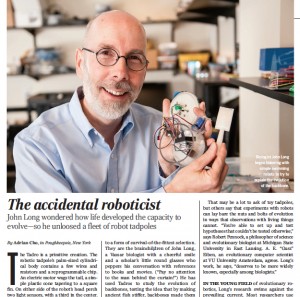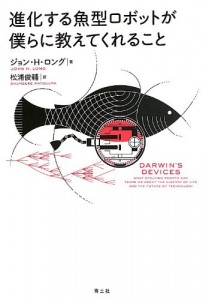Three cheers for Tadros! The simple Tadro-class of robots continues to be a workhorse in our research in evolutionary robotics. We’ve just published an open-access paper in Frontiers in Robotics and AI, in which we have evolved the neural networks of Tadros.
Neural networks connect sensors to motors, so they are analogous functionally to the brain — or really the whole nervous system, including the brain, spinal cord, and peripheral nerves — of animals. Nervous systems of animals are complicated for the simple reason of having many cells with even more connections. Humans have 80 to 100 billion neurons and, by some estimates, nearly 100 trillion connections among them. Mapping those connections is the goal of The Human Connectome Project, a high-powered federal research project in the U.S. But given a map of the connectome, which is only structure, what do we know about the function of the nervous system?
The structural pattern can point us in the direction of different functional sub-systems. We know that the pattern of connections among neurons in animals is neither random nor uniform. Neurons that share more connections with each other than they do with other neurons can be thought of as a cluster or module. The degree to which neurons are preferential connected to some but not all other neurons can be measured as property of the whole connectome known as “modularity,” and is represented by the letter Q and ranges from a value of 0 to 1.
Having some modularity in a nervous system is thought to be important on two levels: function and evolution. Imagine two nervous systems that link a pair of eyes to a pair of muscles powering legs. If one of those nervous systems is completely integrated, with no modularity as indicated by a of Q = 0, then any sensor signal from the eyes propagates throughout the whole nervous system. If the other nervous system has an intermediate level of modularity, Q = 0.5, then it might have the eyes connected in one module to the legs and the eyes connected in another module to the legs.
Those independent modules can easily have different functions. For example, one module might use patterns of light to control the frequency of leg motion and hence forward speed; the other module might use patterns of light to control the asymmetry of the stride and hence the turning motion. It’s not that the fully integrated (Q = 0) nervous system can’t have the same type of what we would call “motor control.” But that fully integrated system has to achieve that same independence of function by different means, possibly by altering properties of the neurons such as their relative excitability in the face of a sensory signal.
The modular system does the trick by simply not connecting the cells of the different functional pathways. This is where evolution comes into play: take the simple path when possible. From some very interesting computer simulations in evolving systems by Jeff Clune and his colleagues, the idea is that modular systems get an evolutionary jump start when there is an energetic cost to having connections. This “connection cost” then drives what we call “sparsity,” the reduction in the number cells and/or their connections.
This functional and evolutionary interplay between modularity and sparsity was something that had been tested in computer simulation but not in physical systems. That’s where Tadros come in. As simple, physical robots, we could evolve the neural networks of Tadros in the real world — with all of its inherent complexities and contingencies — to test the idea that sparsity was the target of evolution by the process known as “selection.” While the results, even in simple Tadros, are complicated (see the paper), the patterns support the hypothesis that (1) sparsity and modularity are linked, probably functionally, and (2) sparsity is the target of selection during evolution.









